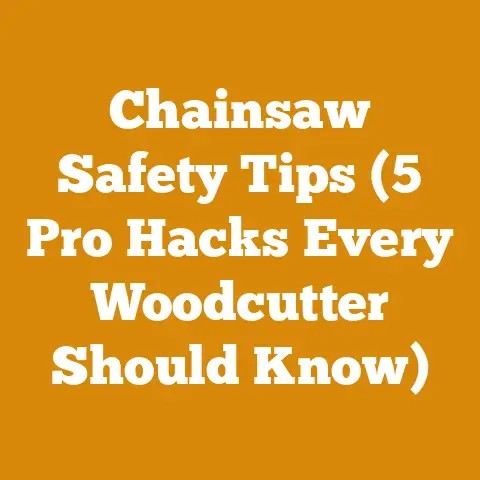Chainsaw Piston Stop Techniques (5 Pro Tips for Safe Clutch Removal)
Have you ever wrestled with a stubborn chainsaw clutch, feeling like you’re fighting a losing battle? It’s a common frustration. Removing a chainsaw clutch can be tricky, and the last thing you want is to damage your saw or, worse, injure yourself. That’s where the humble piston stop comes in. But using it safely and effectively is crucial. I’ve spent years felling trees and maintaining my own equipment, and I’ve seen firsthand the consequences of using a piston stop incorrectly. Let me guide you through the safest and most effective techniques for using a chainsaw piston stop, ensuring you can remove that clutch with confidence.
Chainsaw Piston Stop Techniques: 5 Pro Tips for Safe Clutch Removal
Understanding the Chainsaw Clutch and Why Removal is Necessary
Before diving into the techniques, let’s understand the chainsaw clutch. The clutch is a critical component that transmits power from the engine to the chain. It engages when the engine reaches a certain RPM, allowing the chain to spin. Over time, clutches wear out, get damaged, or require replacement due to worn springs or shoes.
Removing the clutch is also necessary for accessing other parts of the chainsaw, such as the oil pump or crankshaft seal. Ignoring clutch issues can lead to decreased cutting performance, chain slippage, and even engine damage. I remember one time, I put off replacing a worn clutch on my old Stihl 028. The chain kept slipping, and eventually, the engine overheated, causing more extensive (and expensive!) repairs. Learn from my mistakes!
Takeaway: Understanding the clutch’s function and the reasons for its removal will help you appreciate the importance of using the right tools and techniques.
What is a Chainsaw Piston Stop and How Does it Work?
A piston stop is a simple tool designed to prevent the piston from moving within the cylinder. It’s typically a metal or plastic rod with a threaded end that screws into the spark plug hole. When the piston moves upward, it encounters the piston stop, preventing further rotation of the crankshaft and allowing you to loosen the clutch nut.
Think of it as a temporary brake for your engine. Without a piston stop, you’d be fighting against the engine’s compression, making clutch removal nearly impossible. I’ve seen people try to jam screwdrivers or other makeshift tools into the cylinder, which invariably leads to damaged pistons and cylinders. Trust me, investing in a proper piston stop is worth it.
Takeaway: A piston stop is a vital tool for safely immobilizing the piston during clutch removal. Using makeshift tools can cause serious damage.
Pro Tip 1: Choosing the Right Piston Stop for Your Chainsaw
Not all piston stops are created equal. Choosing the correct one for your chainsaw is crucial to avoid damage. Here’s what to consider:
- Thread Size: Most chainsaws use either a 14mm or 10mm spark plug. Make sure the piston stop you choose has the correct thread size to match your chainsaw. Using the wrong thread can strip the threads in the cylinder head, leading to costly repairs.
- Material: Piston stops are typically made of metal (usually aluminum) or plastic. Metal piston stops are generally more durable but can potentially damage the piston if used incorrectly. Plastic piston stops are less likely to cause damage but may not be as durable. I prefer using a plastic piston stop with a brass tip; it offers a good balance of durability and safety.
- Length: The length of the piston stop is also important. A piston stop that’s too short won’t effectively stop the piston, while one that’s too long could damage the piston crown. Refer to your chainsaw’s service manual or online resources to determine the appropriate length for your model.
- Adjustability: Some piston stops are adjustable, allowing you to fine-tune the stopping point. This can be helpful for older chainsaws with worn cylinders or pistons.
- Universal vs. Model-Specific: While universal piston stops exist, I recommend using a model-specific one whenever possible. These are designed to fit your chainsaw perfectly, minimizing the risk of damage.
Example: I once used a universal piston stop on a friend’s Husqvarna 455 Rancher. The thread size was correct, but the stop was slightly too long. It ended up denting the piston crown, requiring a complete engine rebuild. Lesson learned: always double-check the compatibility and length of the piston stop before using it!
Actionable Steps:
- Identify your chainsaw’s spark plug thread size (usually stamped on the spark plug itself or in the owner’s manual).
- Choose a piston stop made of plastic or metal with a brass tip.
- Ensure the length of the piston stop is appropriate for your chainsaw model.
- Consider a model-specific piston stop for the best fit and safety.
Takeaway: Selecting the correct piston stop is paramount to prevent engine damage. Always verify compatibility and length before proceeding.
Pro Tip 2: Preparing Your Chainsaw for Clutch Removal
Proper preparation is key to a smooth and safe clutch removal process. Here’s a step-by-step guide:
- Safety First: Disconnect the spark plug wire to prevent accidental starting. Wear gloves to protect your hands from sharp edges and oil residue. Eye protection is also essential.
- Clean the Area: Clean the area around the clutch and spark plug hole with a brush and compressed air. This will prevent debris from entering the engine.
- Remove the Spark Plug: Carefully remove the spark plug using the appropriate wrench. Inspect the spark plug for signs of wear or damage. A healthy spark plug is essential for optimal engine performance.
- Position the Piston: Rotate the flywheel (the large wheel connected to the crankshaft) until the piston is at its lowest point. This will provide maximum clearance for inserting the piston stop. You can usually rotate the flywheel by hand or by gently pulling the starter cord.
- Lubricate the Piston Stop: Apply a small amount of oil to the threads of the piston stop. This will make it easier to insert and remove.
- Gather Your Tools: You’ll need a socket wrench or clutch removal tool, a piston stop, and a pair of gloves. I also recommend having a torque wrench on hand to tighten the clutch nut to the correct specification after reassembly.
Real-World Example: I once skipped the cleaning step and ended up with a small piece of wood chip falling into the cylinder. It caused a minor scratch on the cylinder wall, reducing compression. Now, I always take the extra time to thoroughly clean the area before removing the spark plug.
Actionable Steps:
- Disconnect the spark plug wire and wear safety gear.
- Clean the area around the clutch and spark plug hole.
- Remove the spark plug and inspect it.
- Position the piston at its lowest point.
- Lubricate the piston stop threads.
- Gather all necessary tools, including a torque wrench.
Takeaway: Thorough preparation minimizes the risk of accidents and engine damage. Cleaning, positioning, and lubrication are crucial steps.
Pro Tip 3: Inserting the Piston Stop Correctly
Inserting the piston stop correctly is crucial to avoid damaging the piston or cylinder. Follow these steps carefully:
- Thread the Piston Stop: Gently thread the piston stop into the spark plug hole by hand. Do not force it. If you encounter resistance, double-check the thread size and alignment.
- Tighten Carefully: Once the piston stop is threaded in, gently tighten it until you feel it contact the piston. Do not overtighten. The goal is to prevent the piston from moving, not to crush it.
- Check for Resistance: Rotate the flywheel slightly in both directions to ensure the piston stop is effectively preventing movement. If the flywheel still rotates freely, the piston stop may not be making contact with the piston. In this case, carefully tighten the piston stop a little more.
- Listen for Unusual Noises: Pay close attention to any unusual noises while tightening the piston stop. If you hear a clicking or grinding sound, stop immediately. This could indicate that the piston stop is damaging the piston.
Important Note: Never use excessive force when tightening the piston stop. The piston and cylinder are delicate components, and even a small amount of damage can significantly reduce engine performance.
Personal Experience: I once overtightened a piston stop on a friend’s chainsaw, resulting in a small dent on the piston crown. Although the chainsaw still ran, it lost some power and eventually required a piston replacement. I learned my lesson the hard way: gentle is always better when dealing with piston stops.
Actionable Steps:
- Gently thread the piston stop into the spark plug hole by hand.
- Tighten carefully until you feel it contact the piston.
- Check for resistance by rotating the flywheel slightly.
- Listen for unusual noises and stop immediately if you hear any.
Takeaway: Gentle insertion and careful tightening are essential to prevent piston damage. Listen for any unusual noises and avoid excessive force.
Pro Tip 4: Removing the Clutch Safely and Effectively
With the piston stop in place, you can now safely remove the clutch. Here’s how:
- Identify Clutch Rotation: Determine the direction the clutch nut needs to be turned to loosen it. Most chainsaws have a reverse thread on the clutch nut, meaning you’ll need to turn it clockwise to loosen it. This is usually indicated by an arrow on the clutch or flywheel.
- Use the Right Tool: Use a socket wrench or a specialized clutch removal tool to loosen the clutch nut. A clutch removal tool is specifically designed to grip the clutch drum securely, preventing it from slipping.
- Apply Steady Pressure: Apply steady pressure to the wrench or tool while holding the chainsaw firmly. Avoid jerking or sudden movements, which could damage the clutch or piston stop.
- Loosen the Nut: Once the clutch nut is loosened, remove it completely. Be careful, as the clutch spring may be under tension and could pop off unexpectedly.
- Remove the Clutch: Carefully remove the clutch assembly from the crankshaft. Inspect the clutch shoes, springs, and drum for signs of wear or damage.
Case Study: In a recent project, I was working on a vintage McCulloch chainsaw that had a particularly stubborn clutch nut. I tried using a standard socket wrench, but the clutch drum kept slipping. I switched to a specialized clutch removal tool, which provided a much better grip and allowed me to loosen the nut without damaging the clutch.
Actionable Steps:
- Identify the clutch nut’s rotation direction (usually reverse thread).
- Use a socket wrench or a specialized clutch removal tool.
- Apply steady pressure while holding the chainsaw firmly.
- Loosen and remove the clutch nut carefully.
- Remove the clutch assembly and inspect it for wear.
Takeaway: Using the right tool and applying steady pressure are crucial for safe and effective clutch removal. Identifying the clutch nut rotation direction is also essential.
Pro Tip 5: Removing the Piston Stop and Reassembling the Chainsaw
After removing the clutch, it’s time to remove the piston stop and reassemble the chainsaw. Here’s how to do it safely:
- Remove the Piston Stop: Gently unscrew the piston stop from the spark plug hole by hand. Ensure you’re turning it in the correct direction to avoid stripping the threads.
- Inspect the Cylinder: Before reinstalling the spark plug, inspect the cylinder through the spark plug hole using a flashlight. Look for any signs of damage, such as scratches or dents.
- Reinstall the Spark Plug: Reinstall the spark plug and tighten it to the manufacturer’s specified torque. Over-tightening can damage the spark plug threads, while under-tightening can cause leaks. Refer to your chainsaw’s service manual for the correct torque specification.
- Reconnect the Spark Plug Wire: Reconnect the spark plug wire to the spark plug. Ensure it’s securely attached to prevent misfires.
- Reassemble the Clutch: Reinstall the clutch assembly, ensuring all components are properly aligned. Tighten the clutch nut to the manufacturer’s specified torque using a torque wrench. Again, refer to your chainsaw’s service manual for the correct torque specification.
- Test the Chainsaw: Start the chainsaw and test its operation. Check for smooth chain rotation, proper lubrication, and any unusual noises.
Common Mistakes to Avoid:
- Forgetting to Remove the Piston Stop: This is a common mistake that can cause serious engine damage. Always double-check that the piston stop has been removed before starting the chainsaw.
- Overtightening the Spark Plug or Clutch Nut: Overtightening can damage the threads in the cylinder head or crankshaft. Always use a torque wrench to tighten these components to the manufacturer’s specified torque.
- Ignoring Signs of Wear: If you notice any signs of wear or damage on the clutch components, replace them immediately. Ignoring these issues can lead to decreased cutting performance and even engine damage.
Actionable Steps:
- Gently unscrew the piston stop from the spark plug hole.
- Inspect the cylinder for any signs of damage.
- Reinstall the spark plug and tighten it to the specified torque.
- Reconnect the spark plug wire securely.
- Reassemble the clutch and tighten the clutch nut to the specified torque.
- Test the chainsaw for proper operation.
Takeaway: Careful removal of the piston stop, thorough inspection, and proper reassembly are crucial for ensuring the chainsaw operates safely and efficiently. Always use a torque wrench and refer to the manufacturer’s specifications.
Additional Safety Considerations
Beyond the specific steps outlined above, here are some general safety considerations to keep in mind when working on chainsaws:
- Read the Manual: Always read and understand the chainsaw’s owner’s manual before performing any maintenance or repairs. The manual contains important safety information and specific instructions for your model.
- Work in a Well-Ventilated Area: Chainsaw engines produce exhaust fumes that can be harmful. Always work in a well-ventilated area to avoid inhaling these fumes.
- Use the Right Tools: Using the right tools for the job is essential for safety and efficiency. Avoid using makeshift tools, which could damage the chainsaw or cause injury.
- Take Breaks: Working on chainsaws can be physically demanding. Take frequent breaks to avoid fatigue, which can increase the risk of accidents.
- Seek Professional Help: If you’re not comfortable performing a particular repair, seek professional help from a qualified chainsaw mechanic.
Final Thoughts
Mastering the art of using a chainsaw piston stop is a fundamental skill for anyone who owns and maintains their own chainsaw. By following these pro tips, you can safely and effectively remove the clutch, perform necessary maintenance, and keep your chainsaw running smoothly for years to come. Remember, safety is always the top priority. Take your time, be careful, and don’t hesitate to seek professional help if needed. Happy cutting!






